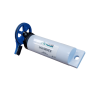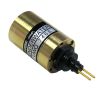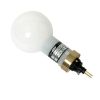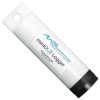PME miniPAR Logger
Features
- Submersible up to 100 meters
- PAR, orientation, and temperature sensors
- Anti-fouling wiper available
- Expedited repair and warranty service
- Lifetime technical support
- More
Overview
The PME minPAR contains a tilt sensor to ensure proper orientation and a temperature sensor. Data is recorded on an internal SD card. The miniPAR is powered by 2 AA batteries and can be fitted with an anti-fouling miniWIPER to protect long-term data accuracy.
Measuring Photosynthetically Active Radiation
The miniPAR is fitted with an LI-192 Underwater Quantum Sensor manufactured by LI-COR. The sensor uses a silicon photodiode and glass optical filters to create a uniform sensitivity to light wavelengths in the 400-700nm range. It measures PAR from all angles in one hemisphere. PAR is a key indicator for understanding nutrient loading, photosynthesis, algae blooms, or other biological, chemical, or physical processes.
Battery Powered
PME is confident that the logger can continue collecting measurements for over one year before the batteries need to be replaced at a sampling interval of one minute. The miniPAR is constructed from strong Delrin plastic that does not easily crack or break.
Embedded Tilt Sensor
The miniPAR is unique among similar loggers in that it contains a tilt sensor to measure the orientation of the device. Since PAR measurement accuracy is dependent upon the sensor being pointed toward the water surface, the tilt sensor will alert the user if the sensor is rotated in a particular direction.
PME Software Included
PME software is provided with every miniPAR logger and can be found on the included SD card when it is connected to a computer. The software creates visual plots to read PAR measurements easily and allows the user to set the internal clock and sample rate.
In The News
Combating Water Insecurity in Saskatchewan with Real-Time Data
The prairies of Saskatchewan can be described as one of the least water-secure parts of Canada, making water quality monitoring essential for informed resource management in a region already facing water insecurity. While natural physical properties worsen some of the poor water quality conditions in the region, others are connected to land use. Having grown up spending summers on the shores of Lake Huron, Helen Baulch, an associate professor at the School of Environment and Sustainability at the University of Saskatchewan , has always been dedicated to the protection of water resources. Looking back fondly at her childhood playing along the shore, Baulch also recalls the invasion of quagga mussels during her teenage years and watching the lake change as a result.
Read MoreSeametrics Turbo Turbidity Logger: Boost your Turbidity Monitoring
The Seametrics Turbo Turbidity Logger is a self-cleaning turbidity sensor capable of internally logging over 260,000 data records. The sensor enables researchers, compliance officers, and contractors to monitor turbidity in various applications, from construction and dredging sites to wastewater effluent. Due to its narrow width, this device can be deployed in a range of areas, from small well spaces to rivers and streams. The stainless steel housing and built-in wiper allow the sensor to withstand long-term deployments and reduce the need for maintenance trips. The logger accurately records temperature and turbidity up to a depth of 50 meters.
Read MoreCollecting Data at the Top of the World: How Scientists Retrieve Glacial Ice Cores
A helicopter touches down in the small town of Sicuani, Peru, at an elevation of 11,644 feet. Earlier that day, a boxcar brought fuel, drills, food, and other equipment for a glacial expedition. The year is 1979, and glaciologist Lonnie Thompson is preparing to lead a team to the Quelccaya ice cap in hopes of becoming the first scientists to drill an ice core sample from this glacier. The only problem? The glacier is located at 19,000 feet in one of the most remote areas of the world. The helicopter takes off from the town, but the thin atmosphere at that elevation does not allow it to safely touch down on the ice– due to the aircraft’s weight, and it becomes unstable when the air is less dense.
Read More
















